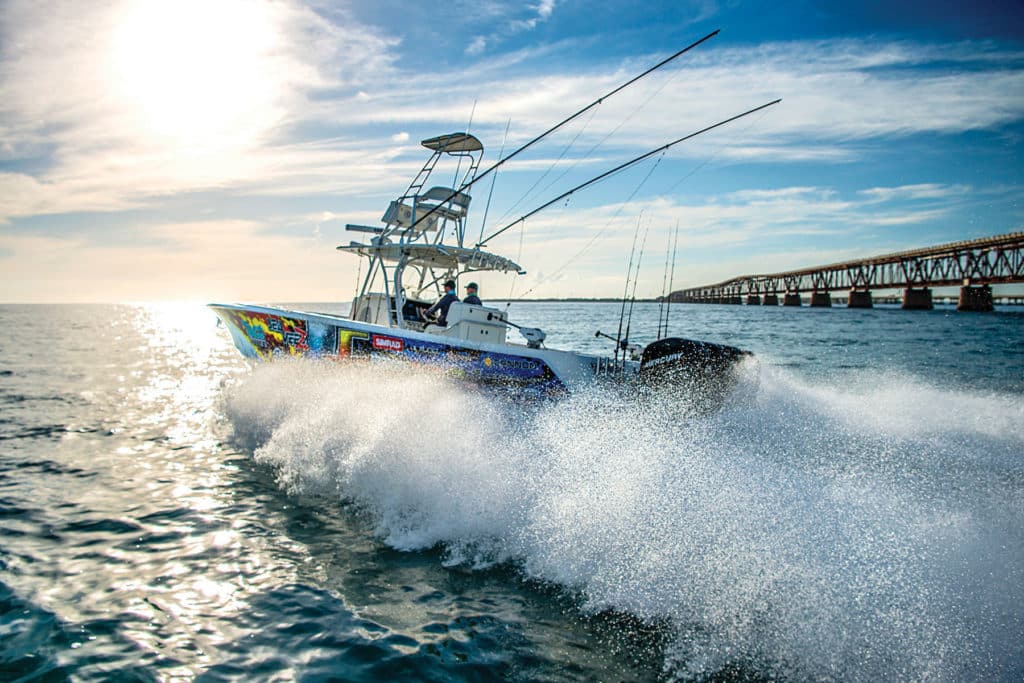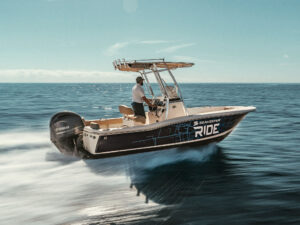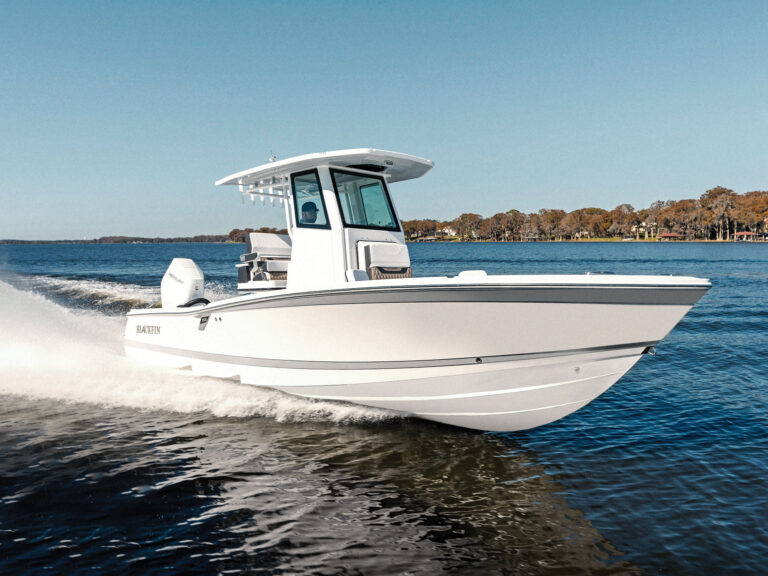
For boating anglers, catching quality fish is only half the equation. Getting to the fishing spots efficiently, comfortably and safely are also important aspects of the game. How the boat is rigged is a factor, but the helmsman plays a significant role in setting the boat’s running attitude, balance and headway. Four pros with different platforms share what they do to achieve optimum performance in real-world conditions.
Capt. Ryan Spear averages more than 140 days per year chartering out of Pirate’s Cove Marina in Manteo, North Carolina. He runs nearshore trolling trips for mackerel, bluefish, false albacore and dolphin. His boat is an Outer Banks Boatworks 30-foot center-console with a 250-gallon fuel capacity, powered by twin Yamaha F300 outboards.
He starts the day with the engines trimmed up just a bit and keeps them like that all day. “That allows the boat to come up out of the water better,” Spear says. “I make the big adjustments with the trim tabs and throttle. Mercury racing tabs are long and really let me get the bow up where it’s comfortable. I easily adjust to the existing sea conditions, so the boat is not too squatty and not so much on top that it gets squirrelly.”
Spear likes to run with a full tank of fuel, and distributes his passengers to maintain an even balance. He achieves top fuel economy running at 22 to 23 knots (3,300 to 3,400 rpm), burning 10 gph. When navigating Oregon Inlet’s difficult breakers, he steers at a 50-degree angle, if possible. “The bow flare lets me bust through the breakers, and I keep the momentum with throttle adjustments,” he says.
Capt. Jason Prieto guides clients to redfish, snook and tarpon in Tampa Bay, Florida, aboard a Pathfinder 2500 Hybrid equipped with a tower. His bay boat is powered by a Mercury Verado 300 with a Rev 4 19-pitch, three-blade propeller, which gets 3.2 mpg while running 41 mph.

Prieto’s Verado is mounted on an Atlas jack plate. When he needs to get up in skinny water, he runs the jack plate all way up, trims the engine down, and finds a hole to pop on plane. “I need 2 feet of water to jump up, but I can run in about 14 inches,” he says.
“I don’t use the trim tabs, except when it’s snotty and there’s a strong wind coming from the side,” he explains. “With the stepped hull, I just give the engine some positive trim, and it drives pretty well, once you get the boat up on the pad and steps.”
Capt. C.A. Richardson calls Crystal River, Florida, home, but he also fishes the Louisiana marshes. His craft is an 18-foot Hell’s Bay Marquesa with carbon Innegra layup—with no jack plate or trolling motor, to save weight—and an Evinrude G2 E-Tec 140 hp mounted on the third hole of the transom.
“You gotta be a good driver with these higher-horsepower outboards. With such hole shot, speed and light weight, you really have to pay attention,” he says. “I don’t like to overuse the tabs, but if I need to get moving, I drop the starboard tab down and keep the port one up. A quick left turn followed by a right lifts the stern, and I’m on plane in half a boat length,” he adds.
Custom modifications and a tunnel hull design let Capt. Tom Horbey run the shallow flats near Port O’Connor, Texas. Horbey owns a Chittum Laguna Madre technical poling skiff, powered by a 50 hp Tohatsu mounted on a Bob’s Machine jack plate with wedges.
Additional shims on the trim tabs allow negative trim, and a carbon-fiber chute extending beyond the transom tunnel channels the water straight back over the propeller: a Jack Foreman-modified three-blade prop with triple cups. Low-water pickups enable Horbey to run with the prop raised above the bottom of the hull.
“There are no drawbacks to a tunnel hull on the Texas flats,” he claims. “I lose a little top-end speed, but run shallower and access water others can’t.”
When moving to a different spot, Horbey poles out to deeper water and raises the outboard all the way up on the jack plate. One tab is depressed while the other remains up. Then a quick counterclockwise spin under power lifts one side of the skiff to break loose. Once on plane, he lowers the motor.
“I also have a customer sit on the bow or one side to adjust the load,” Horbey says. “If it’s rough, I’ll put everyone in back to keep the bow up.”
You don’t have to be a professional to maximize your boat performance. Experiment with trim and be mindful of the load and sea conditions, and you’ll discover that sweet spot.
Trim Tabs: These adjust the boat’s attitude to compensate for weight distribution and sea conditions.
Jack Plate: This allows vertical outboard adjustments to take off and run in shallow water, and it improves overall performance.
Throttle: The skipper’s touch on the throttle plays a major role on the boat’s ride, performance, fuel efficiency and range.









